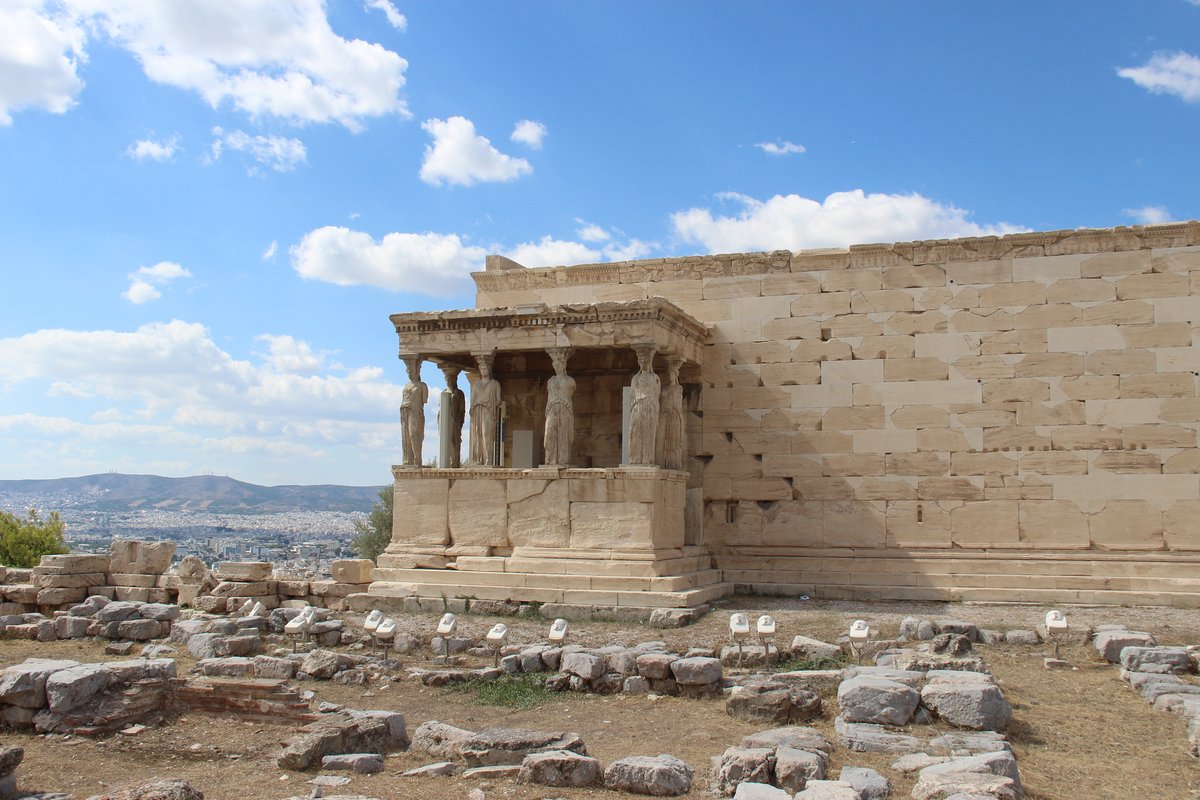
Erechtheion Athens: Visiting Hours, Tickets, and Historical Significance
Date: 14/06/2025
Introduction
The Erechtheion is one of the Acropolis of Athens’ most enigmatic and architecturally sophisticated monuments, embodying centuries of myth, religion, and civic pride. Unlike the symmetrical Parthenon, the Erechtheion’s irregular layout was designed to accommodate sacred relics, multiple cults, and legendary events in Athenian mythology. Its most famous feature—the Porch of the Caryatids—continues to captivate visitors with its blend of artistry and symbolism. Whether you are a history enthusiast or a first-time traveler, understanding the Erechtheion’s layered past and practical visitor information will enhance your experience at this iconic Athens historical site (Acropolis Greece; Greek History Hub; World History Encyclopedia; Acropolis Tickets).
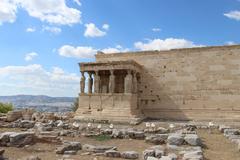

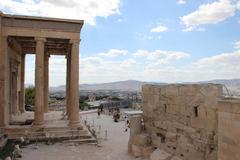

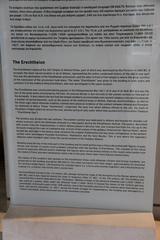
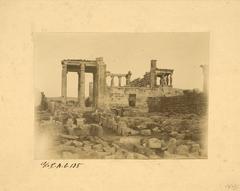
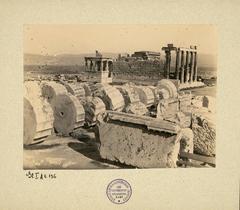
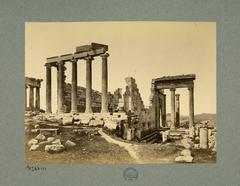
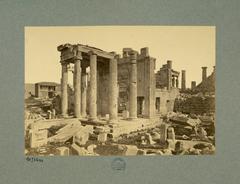
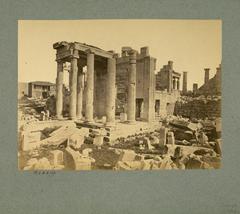
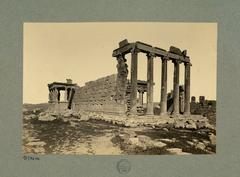 Erechthéion, vu du sud-est. - Cette photographie appartient à l'album Classische Landschaften und Denkmäler aus Griechenland, Kleinasien und Palästina publié en 1881. Le cadrage permet d'appréhender le temple dans toute sa longueur, tout en mettant nettement l'accent sur le côté est. Sur le stylobate du portique est, au niveau de l'emplacement de la colonne nord (emportée par Lord Elgin en 1801 avec son entablement), nous observons la présence d'une base de couleur foncée qui n'apparaît pas sur les photographies antérieures.
Erechthéion, vu du sud-est. - Cette photographie appartient à l'album Classische Landschaften und Denkmäler aus Griechenland, Kleinasien und Palästina publié en 1881. Le cadrage permet d'appréhender le temple dans toute sa longueur, tout en mettant nettement l'accent sur le côté est. Sur le stylobate du portique est, au niveau de l'emplacement de la colonne nord (emportée par Lord Elgin en 1801 avec son entablement), nous observons la présence d'une base de couleur foncée qui n'apparaît pas sur les photographies antérieures.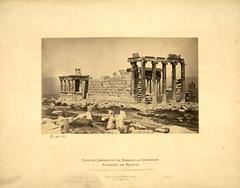
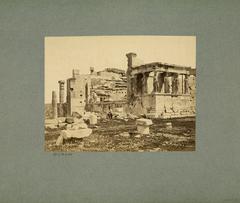
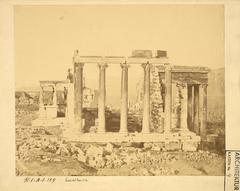
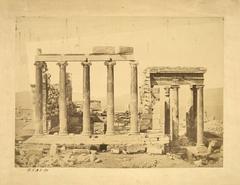
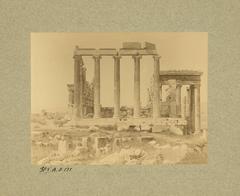
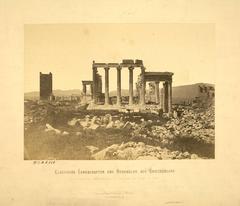
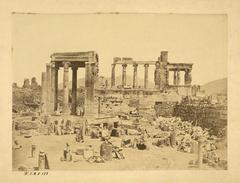
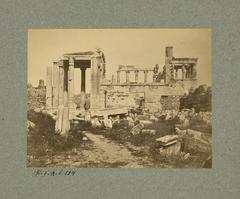
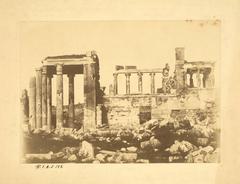
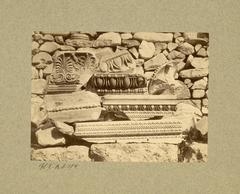
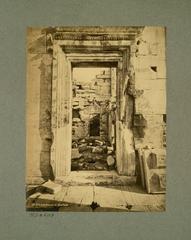

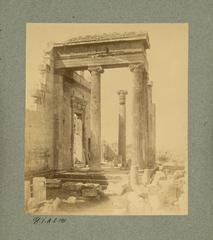
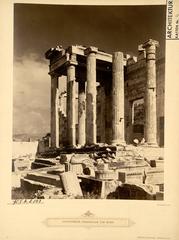
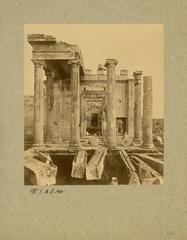
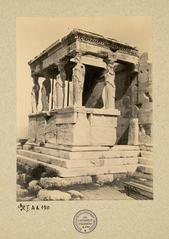
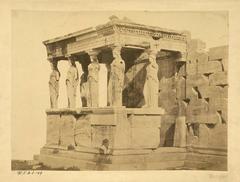
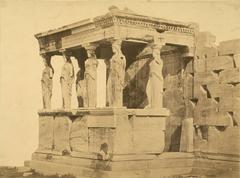
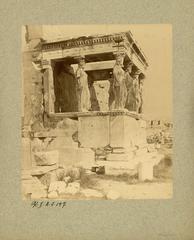

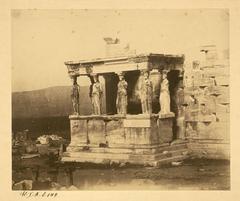
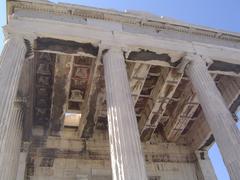
Quick Navigation
- Historical Overview
- Practical Visitor Information
- Architectural Highlights
- Visitor Experience Tips
- FAQ
- Nearby Attractions
- Summary & Travel Resources
- References
Historical Overview
Origins and Mythological Foundations
Named after the mythical king Erechtheus, the Erechtheion’s site is intimately connected to the legendary contest between Athena and Poseidon for Athens’ patronage. According to myth, Poseidon struck the Acropolis rock, creating a saltwater spring, while Athena’s gift—an olive tree—symbolized prosperity and peace. Both the olive tree and the saltwater well were incorporated into the temple precinct, representing the city’s divine origins and identity (Acropolis Greece).
Construction and Architectural Innovation
Built between 421 and 406 BCE under Pericles’ leadership, the Erechtheion was part of Athens’ post-Persian War reconstruction. The architect Mnesicles designed the temple to fit the Acropolis’ uneven terrain, resulting in a multi-level, asymmetrical structure crafted from high-quality Pentelic marble. The building accommodates several ancient sanctuaries and cults within its complex plan (World History Encyclopedia; Warbleton Council).
Religious Functions and Sacred Relics
The Erechtheion was a multi-purpose sacred site. It housed the ancient wooden statue of Athena Polias, focal point of the Panathenaic Festival, and contained shrines for Poseidon, Hephaestus, Erechtheus, and other heroes. Relics such as Poseidon’s trident mark and Athena’s olive tree emphasized its central role in Athenian religious life (Acropolis Greece).
The Porch of the Caryatids
The south porch features six sculpted maidens—Caryatids—serving as both columns and symbols of civic virtue. Five original Caryatids are preserved in the Acropolis Museum, while one remains in the British Museum. Replicas stand on the monument today (Acropolis de Atenas; World History Encyclopedia).
Later Transformations and Restoration
The Erechtheion’s uses changed over time: it became a Christian church, later a palace, and then a residence during the Ottoman era. It endured damage in wars and was the first Acropolis monument to undergo systematic restoration in the 19th century, with ongoing conservation focusing on structural stability and artifact preservation (Warbleton Council).
Practical Visitor Information
Visiting Hours (2025)
- Summer (April–October): 8:00 AM – 8:00 PM
- Winter (November–March): 8:00 AM – 5:00 PM
Hours may change on holidays and special occasions. Always confirm via the official Acropolis website.
Tickets and Entry
- Standard Adult Ticket (2025): €30 (timed entry to entire Acropolis, including Erechtheion)
- Reduced/Free Admission: For EU students, children under 18, and seniors (documentation required)
- Acropolis Pass: 48-hour validity, covers multiple sites in Athens (Insights Greece)
Purchase tickets online in advance to avoid queues. Entry is permitted from 15 minutes before to 60 minutes after your timeslot (Earth Trekkers; Thenovelsphere).
Accessibility
- The Acropolis terrain is rocky and uneven; a lift is available for visitors with mobility challenges, though not all areas are accessible (Take Me To Europe Tours).
- Wear sturdy shoes and bring water, especially in summer.
Architectural Highlights
- Asymmetrical Layout: Designed to conform to the Acropolis’ natural rock and to house multiple shrines (World History Encyclopedia).
- Ionic Order: The Erechtheion is a masterpiece of the Ionic style, with slender fluted columns and detailed capitals (Acropolis Tickets).
- Porch of the Caryatids: Six exquisitely carved maidens serving as both columns and symbols.
- Sacred Relics: Features the precinct of the olive tree, Poseidon’s trident mark, and the tombs of Erechtheus and Cecrops (Ancient Greece Wanderings).
- Materials: Pentelic marble, with original painted and bronze details.
- Interior Division: Multiple chambers dedicated to Athena, Poseidon, and legendary kings (Archaeology Magazine).
Visitor Experience Tips
- Best Times to Visit: Early morning (8:00–10:00 AM) or late afternoon (after 5:00 PM) for cooler temperatures and fewer crowds (Insights Greece).
- Safety: Surfaces can be slippery, especially after rain. Avoid during thunderstorms.
- Photography: Permitted, but tripods may be restricted. The Caryatids and olive tree are popular photo spots.
- Facilities: Restrooms near the main entrance and Acropolis Museum; no food or drink vendors inside the site.
- Guided Tours: Recommended for deeper understanding; many focus on Erechtheion’s architecture and mythology (Insights Greece).
FAQ
Are Erechtheion tickets valid for other Acropolis sites?
Yes, your ticket covers the entire Acropolis complex.
Is the Erechtheion accessible for people with disabilities?
A lift is available, but some uneven areas may be challenging.
When is the best time to visit to avoid crowds?
Early mornings and late afternoons, especially outside peak summer months.
Can I take photos?
Yes, but tripods are generally not allowed.
Are guided tours available?
Yes, both group and private tours are widely offered.
Nearby Attractions
- Parthenon: The most famous temple on the Acropolis.
- Temple of Athena Nike: A small, elegant shrine at the southwest corner.
- Acropolis Museum: Houses original Caryatids and other artifacts (Acropolis Museum).
- Ancient Agora and Theater of Dionysus: Both within walking distance.
Summary & Travel Resources
The Erechtheion offers a profound journey through ancient Athens, blending architectural mastery, myth, and history. Planning ahead with knowledge of visiting hours, ticketing, and accessibility ensures a rewarding experience. Pair your visit with the Acropolis Museum and nearby sites for a comprehensive understanding of Athens’ cultural heritage (Acropolis Greece; Acropolis Museum).
For updates, travel tips, and audio guides, download the Audiala app, explore our related posts, and follow us on social media.
References
- Erechtheion Mysteries & Legends – Acropolis Greece
- Erechtheion Architecture – Acropolis Tickets
- Cultural Heritage of the Acropolis – Greek History Hub
- Visiting Erechtheion – Insights Greece
- Acropolis of Athens Restoration – Archaeology Magazine
- Erechtheion Overview – World History Encyclopedia
- Erechtheion – History Tools
- Acropolis Museum Official Site


















































































